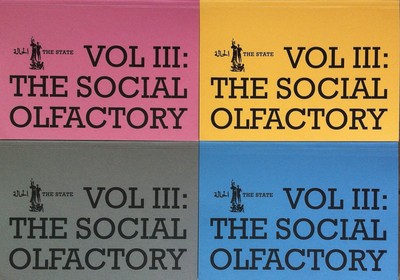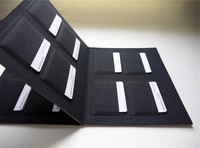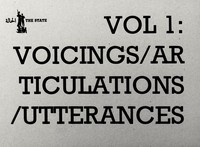
THE STATE
THE STATE is a publishing practice based out of Dubai, U.A.E. It investigates South-South reorientations, alternative futurisms, transgressive cultural criticism, the transition from analogue to digital, and the sensuous architecture of this “printernet.”
- 858 (587)
- United Arab Emirates
- Four issues a year
- Culture, Literature, Science & Technology
- First issue 2012
“THE STATE VOL III: THE SOCIAL OLFACTORY”
AED 50.00 — Released 12 December 2012
- Often, smell can feel like the last sensory frontier. Still a little visceral, still less explored—and exploited—than its other, far more interfaced and corporatised counterparts. When we talk about scent, too, we tend to turn to the natural as a means to efface the natural—sea breezes and floral bouquets to mask perspiration and cooking smells. But then there’s indolic smells, or those fetid-sweet, narcotic compounds found mostly in white flowers like jasmine, nargis, tuberose and honeysuckle. Seductive as they might be, there’s something in them that’s a little bit putrescine, cadaverine. The smell of something rotten in the social factory.
And then there’s Proust. To paraphrase contributor Francisco Salas Pérez, we’re tired of madeleines, and of Western civilisation’s reductive straightjacket of smell and memory. What else can smell do? How do we hack into audiovisual hegemony? What other new olfactory disciplines might emerge?
- In this volume, smell pervades and lingers like heat—in the hazy fetor of a rural Irish landfill, in the quiet occultism of a fermenting Malagasy corpse, in the atomised, repetitive paranoia induced by burning toast, in the crystalised disappointments that follow one man through his life. Sometimes it rolls off the sweaty, porous borders of Empire, as a vehicle for racism and xenophobia and as a means of sanitation and surveillance. Elsewhere, smell works to debunk liberal axioms of recycling and development aid with psychogeographic takes on the souk in Nyala, Sudan, and Detroit’s Little Hungary.
A further set of pieces considers the biochemical science of scent and our olfactory system—all too easy to take for granted, yet nearly impossible to electronically replicate. Olfactory archaeology is mobilised to reveal architectural and sociohistorical traces, traversing time and geography. And completing the sensory fan dance is a look at the perfume industry’s gendering of leather, and how it works hard to hide the human—and animal—body.
- Aya Al-Kadhimi’s design for this volume continues to interrogate the printernet, with a foray into gridded social media and hover effects. And as befitting a volume dedicated to smell, we wanted to explore articulations of scent, too. Print nostalgists often rhapsodise about the musty, vanillic aroma of decomposing lignin, the polymer responsible for yellowing pages and that old book smell. Others cite the crispness of a fresh newspaper, and fingers blurred with ink. Reading with e-ink and backlit displays, however, has so far proved to be a largely anosmic experience. What will the pixels of tomorrow smell like?
What do you think of this issue?
Sign up or Log in to join the discussion.
Recent activity
- 08 Apr, 2015 Wanted by archmemory
- 10 Mar, 2014 Bought from the Magpile Store by muschiosa
- 19 Jun, 2013 Wanted by rawan
- 18 Jun, 2013 Added to pile by cnqmdi
- 30 May, 2013 New cover uploaded by thestate_
- 30 May, 2013 Added to Magpile by thestate_



